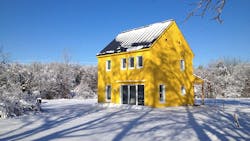For Alexi Arango, assistant professor of physics at Mount Holyoke College, the idea of driving a lesson home has taken on a whole new meaning.
For years, Arango has been telling the students in his renewable energy class about a passive house in Maine, and they’ve been captivated by the idea of a home so efficient that it’s heated without a furnace. “I love the reaction,” he says. “There’s disbelief, and the concept almost seems magical. Then you go through it and talk about the physics, and it’s really not some wild idea.”
Now, however, Arango’s students have a new house to study—his.
Working with Belfast, Mainebased architecture firm GO Logic and Amherst, Ma.-based Integrity Development & Construction, Arango recently completed and moved into his own 1,000-square-foot passive house. But with this home, his students will get to do much more than just hear about it.
Arango, whose research focuses on solar energy systems, has equipped every circuit, device, and appliance in the home with an energy-monitoring system. As part of the system, his students can download an app onto their phones or computers and monitor, in real time, the energy that ordinary household tasks consume.
“The point is to remove the mystery of energy use and understand the impact of one’s behavior,” Arango says. “It’s fascinating to walk around the home, turn on a faucet or appliance, and see exactly how much energy is being used.” The home is also set up for solar panels, which Arango wants to eventually add—as well as an electric vehicle charging station—in hopes of taking the home entirely off the grid. For nearly a year, Arango documented the entire building process on a blog (potwinepassive.blogspot.com) detailing for his students the underlying principles and systems being applied to the home’s design and construction and how they would ultimately allow it to achieve its remarkable performance. Now that he has moved in, however, he’s touting more than the home’s efficiency.
“It’s hard to understand a passive house until you live in one,” Arango says. “Part of the story is the technical side, but the other side is the comfort.” The professor points to the health benefits of not burning fossil fuels in the home, consistent temperatures across rooms, fresh air, plentiful sunlight, and the tranquility of a home that doesn’t have a heater switching on and off, adding, “It’s just a better way to live.” PB
